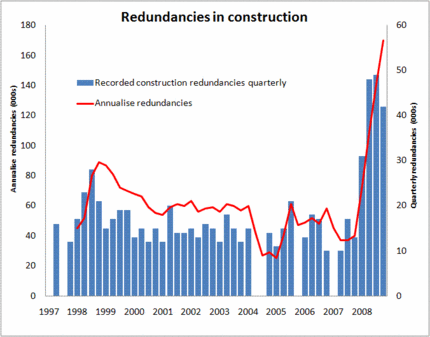111,000 jobs lost to construction… and that is just the start
The latest employment figures make grim reading for the construction industry with the number of workforce jobs plunging by 61,000 in the second quarter of this year.
This means that 111,000 jobs have been lost to the industry since they peaked in the autumn last year.

In fairness the drop in workforce jobs has been coming for some while and it has been a mystery as to why the numbers had held up so well for so long given the severe downturn in construction output and the surging numbers being made redundant.

The latest data do in fact show that earlier figures for workforce jobs in construction have been revised down, with 5,000 jobs shaved off the 2008 third quarter peak figure and with the figure for the first quarter of this year showing 15,000 fewer jobs than were estimated three months ago.
Employment is seen as a lag indicator, so with the falls in the level of workload still running we should expect this fall in employment to be a marker for more substantial falls in the coming quarters.
Given the level of uncertainty over the economy generally and the prospects for public investment attempting to make accurate estimates of job losses is near futile. But with what we know now it is not unreasonable to assume that somewhere between a quarter and a third of construction jobs are at risk.
So we could be looking at between 500,000 and 700,000 job losses in construction.
But however expected these figures are they represent a severe concern for the industry, which has been plagued by the effects of erratic levels of employment that have stymied attempts to improve the level of skills.
If the past provides any clues to the future, the industry is currently set to see a rapid loss of jobs followed by a very sluggish pick up in employment when growth returns. This will then be followed by skills shortages.
With vacancies at near starvation levels there is little for the job hunting construction worker to feed on, so they will migrate to other industries and be lost to construction.
From an industry policy perspective the emphasis appears currently to be heavily based on pressing the Government to fund new construction projects.
This I believe is a mistake.
If jobs are the issue this perhaps should be rethought. The view widely shared among those who I suspect better understand the figures is that more emphasis should be put on repair and maintenance work, which tends to far more labour intensive for the level of spend and far better at creating “local” jobs.
What is more, repair and maintenance also plays much more effectively to the green agenda, so would provide the industry with a far more persuasive argument.
3 thoughts on “111,000 jobs lost to construction… and that is just the start”
Thinking specifically about housing rather than other construction projects:
“…more emphasis should be put on repair and maintenance work, which tends to far more labour intensive for the level of spend and far better at creating “local” jobs.”
How would that square with the need to provide more affordable rented housing and Shelter’s target to provide everyone with a home by 2012?
Could there be a one size fits all across the country? Can you idenitfy enough empty housing to bring back into use or bring up to standard?
welcome your thoughts
Cathy
As you recognise the point I was making was more in relation to construction more widely than housing. And it was made specifically in relation to job creation, where on average refurbishment work creates more jobs than new work.
So it may be more cost effective and socially useful to refurbish schools when workloads are slack and workers are on the dole rather than building new ones. Basically because in a recession you can set against the cost to the taxpayer of the work the reduction in benefits and increase in income tax generated from creating more jobs.
The comment, however, has to be seen in the round and is about the balance of work between refurb and new work across the country. Clearly you can’t refurbish empty homes if there are none.
But to answer your point more directly. There are hundreds of thousands of empty homes in the UK, although not all will necessarily be where you might want them most. But making a bigger effort to bring more of these back into use could go a long way to reducing homelessness.
With house building at low levels it seems even more appropriate to look at this approach to meeting housing targets.
On the subject of which you may find this link of interest on the subject of empty homes: http://www.emptyhomes.com
In the useful information section it has listings of where the empty homes are.
Many thanks Brian
Comments are closed.